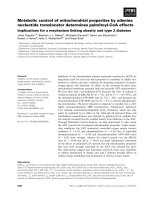Báo cáo khoa học: microRNA-203 suppresses bladder cancer development by repressing bcl-w expression potx
Bạn đang xem bản rút gọn của tài liệu. Xem và tải ngay bản đầy đủ của tài liệu tại đây (282.24 KB, 7 trang )
microRNA-203 suppresses bladder cancer development by
repressing bcl-w expression
Juanjie Bo, Guoliang Yang, Kailing Huo, Haifeng Jiang, Lianhua Zhang, Dongming Liu and
Yiran Huang
Department of Urology, Renji Hospital, Shanghai Jiaotong University, China
Introduction
Human bladder cancer is the fourth most common
malignancy in men, and the tenth most common in
women [1]. Molecular and pathological studies suggest
that bladder cancers comprise at least two major
groups. The majority of malignant bladder tumors are
urothelial cell carcinomas evolved from the epithelial
lining of the bladder wall [2]. The urothelial carcino-
mas are noninvasive papillary tumors that commonly
recur, but rarely progress [3]. Patients with tumors in
this group require long-term monitoring. Invasive
bladder tumors are more aggressive, presenting with
penetration of the basement membrane or invasion
into muscle. Patients with invasive disease have a
much worse prognosis, with a 5-year survival rate of
50% [4]. The high frequency of recurrence of noninva-
sive urothelial carcinoma and the poor prognosis of
invasive bladder tumors highlight the necessity for
development of effective targeted therapies [5]. How-
ever, the lack of effective therapies for advanced blad-
der cancer is related to poor understanding of the
molecular mechanisms underlying the progression of
this disease [6].
Apoptosis is believed to be the major mechanism of
chemotherapy ⁄ radiotherapy-induced cell death in blad-
der cancer [7]. Unfortunately, many tumor cells evade
drug-induced death signals, and certain oncogenes such
as bcl-2 and bcl-w can become overexpressed, resulting
in chemotherapy ⁄ radiotherapy resistance [8]. Bcl-2
family proteins are essential regulators of apoptosis,
and bcl-w is anti-apoptotic member of this family.
Bcl-w maintains cell viability by preventing mitochon-
dria-mediated apoptosis [9,10]. Overexpression of bcl-w
can prevent cell death, and is a potential mediator of
resistance to several chemotherapeutic drugs [11].
Keywords
apoptosis; bcl-w; bladder cancer; miR-203;
proliferation
Correspondence
D. Liu, Department of Urology, Renji
Hospital, School of Medicine Shanghai
Jiaotong University, No. 145 Shan Dong
Middle Road, Shanghai 200001, China
Fax: +86 21 6373 0455
Tel: +86 21 6373 0455
E-mail:
(Received 16 November 2010, revised 13
December 2010, accepted 22 December
2010)
doi:10.1111/j.1742-4658.2010.07997.x
It is increasingly clear that microRNAs (miRNAs) play an important role
in many diseases, including tumorigenesis. However, the mechanisms by
which miRNAs regulate bladder cancer development remain poorly under-
stood. Here, we evaluated the expression of microRNA-203 (miR-203) in
bladder cancer tissues using real-time PCR, and defined the target genes
and biologically functional effect using luciferase reporter assay, flow
cytometry and western blot analysis. We first verified that the expression of
miR-203 was decreased in bladder cancer tissues. Moreover, ectopic expres-
sion of miR-203 promoted the apoptosis of human bladder cancer cell lines
and inhibited cell proliferation, whereas its depletion increased cell growth.
We further verified that miR-203 directly targeted 3¢ -untranslated region of
the bcl-w gene, and decreased its expression in vitro and in vivo. Western
blot analysis also showed that the expression level of miR-203 was nega-
tively correlated with bcl-w level in tumor tissues. These data suggest an
important role for miR-203 in the molecular etiology of bladder cancer
and implicate the potential application of miR-203 in bladder cancer
therapy.
Abbreviations
miRNA, microRNA; miR-203, microRNA-203; UTR, untranslated region.
786 FEBS Journal 278 (2011) 786–792 Journal compilation ª 2011 FEBS. No claim to original Chinese government works
However, the regulation of endogenous bcl-w expres-
sion is complex. For example, Michela et al. showed
the role of Akt in apoptosis resistance by interacting
with bcl-w [12]. They demonstrated that Akt interacted
with the N- and C-terminal sequences of the bcl-w
protein, and phosphorylated bcl-w both in vitro and in
the intact cell. Lapham et al. [13] demonstrated that
TCF4 and beta-catenin interacted with the bcl-w pro-
moter, and the activity of the bcl-w promoter was
increased or decreased, respectively, by overexpression
of beta-catenin or dominant negative TCF4. Lin et al.
[14] showed that bcl-w is a direct target of miR-122
that functions as an endogenous apoptosis regulator in
these HCC-derived cell lines.
There is increasing evidence that post-transcriptional
regulation of gene expression, mediated by micro-
RNAs (miRNAs), plays an important role in the con-
trol of cells proliferation, apoptosis and tumorigenesis
[15–17]. miRNAs are noncoding RNAs that have been
highly conserved during evolution and have emerged
recently as potent regulators of gene expression. Over-
expression of oncogenic miRNAs and underexpression
of tumor suppressor miRNAs play pivotal roles
in tumorigenesis. Gottardo et al. [18] compared the
miRNA profile of bladder cancers and noncancer blad-
der tissues, and found that 10 miRNAs were upregu-
lated. MicroRNA-203 (miR-203), possessing a tumor
suppressive activity, was also downregulated in bladder
cancer tissues [19,20]. However, the relationship
between miR-203 and bladder cancer is remains
unknown.
In this study, we investigated the role of miR-203 in
bladder cancer development. We demonstrated that
expression of miR-203 was downregulated in bladder
cancer tissues, and decreased expression of miR-203
contributed to cells proliferation. Finally, we confirmed
that bcl-w is the direct target of miR-203.
Results
Expression of miR-203 is significantly
downregulated in bladder cancer
In order to assess the role of miR-203 in bladder can-
cer development, we first evaluated the different
expression of miR-203 in bladder cancer tissues and
normal bladder tissues by using quantitative real-time
PCR. Figure 1 shows that miR-203 was expressed at
low levels in bladder cancer tissue, and miR-203 levels
were increased in normal bladder tissue. The mean
level of miR-203 expressed in normal bladder tissues
was 2.7, whereas the mean level of miR-203 expressed
in bladder cancer tissues was 1.4 (Fig. 1). These data
indicate that down-regulation of miR-203 may be
related to bladder cancer development.
miR-203 promotes cells apoptosis in vitro
To study the physiological role of miR-203 in cell
growth, bladder cancer cell lines treated with miR-203,
or microRNA control, were analyzed. Figure 2A
shows that overexpression of miR-203 promoted cell
apoptosis in T24 cells, a bladder cancer cell line. More-
over, compared with the nonspecific microRNA con-
trol (NC), miR-203 inhibited T24 cells proliferation
(Fig. 2B), whereas its depletion promoted cell growth
(Fig. 2C). These data suggest that miR-203 negatively
regulates the growth of bladder cancer cells.
bcl-w is a target gene of miR-203
In order to identify the target genes of miR-203 in regu-
lating bladder cancer cell apoptosis, we searched for
candidate genes using TargetScan 5.1 (http://www.
targetscan.org/) and miRBase (base.
org/) microRNA databases. The bcl-w gene is one of
predicted target genes of miR-203 (Fig. 3A), and is an
important member of the bcl-2 family described as one
of the anti-apoptotic protein. So, we constructed a fire-
fly luciferase reporter containing the 3¢-untranslated
region (UTR) of bcl-w. We then cotransfected HEK293
cells with the pGL3-promoter–bcl-w–3¢-UTR and
miR-203. The reporter assay showed that miR-203 was
0.0
Normal Tumor
*
0.5
1.0
1.5
2.0
2.5
3.0
3.5
4.0
5.0
miR-203 relative level
4.5
Fig. 1. miR-203 was downregulated in bladder tumor tissues. Analy-
sis of miR-203 expression level was performed in bladder tumor
tissues (n = 13) or normal bladder tissues (n = 9). Total RNA was
subjected to real-time RT-PCR to analyze the expression level of
miR-203 in each sample. U6 was used as reference for miRNAs.
Each sample was analyzed in triplicate. The 2
)DDCt
method was used
to determine the relative quantization of gene expression levels.
*P < 0.05.
J. Bo et al. miR-203 suppresses bladder cancer
FEBS Journal 278 (2011) 786–792 Journal compilation ª 2011 FEBS. No claim to original Chinese government works 787
able to significantly repress luciferase expression
of pGL3-promoter–bcl-w–3¢-UTR (Fig. 3B), and
mutation of four nucleotides in the miR-203 target
sequence led to complete abrogation of the suppressive
effect (Fig. 3B). Moreover, we observed that ectopic
expression of miR-203 decreased the bcl-w protein
content in a time-dependent manner in T24 cells
(Fig. 3C). These observations confirm that miR-203
inhibits endogenous bcl-w in bladder cancer cells.
miR-203 expression is inversely related to bcl-w
expression in bladder cancer
To further examine the relationship between miR-203
and bcl-w in bladder cancer tissues, the expression of
miR-203 and bcl-w were detected. Our data showed
that miR-203 levels were decreased in bladder cancer
samples. bcl-w expression in bladder cancer samples
was analyzed by western bloting. The bcl-w levels in
bladder cancer samples were significantly higher than
in normal tissue samples (Fig. 4). Importantly, Fig. 4
shows that bcl-w expression was increased in bladder
cancer tissues that showed significantly decreased miR-
203 expression.
miR-203 suppresses bladder cancer progression
by repressing bcl-w
Bcl-w is an important determinant of cells prolifera-
tion or apoptosis in cancer development, and ele-
vated expression of the bcl-w resulted in abnormal
cell growth with reduced capability for apoptosis in
many cancer types. Therefore, we thought that the
role of miR-203 in bladder cancer cells growth was
mediated by modulating bcl-w expression. Figure 5
shows that T24 cell proliferation was restored when
bcl-w was re-expressed in cells treated with miR-203.
These data confirm that miR-203, at least in part,
inhibited bladder cancer progression by repressing
bcl-w.
0
0
0
0.5
1
1.5
2
2.5
3
3.5
5
10
15
NC miR-203
*
*
*
*
*
NC
NC
miR-203
miR-203-
inhibitor
12
0
0.1
0.2
Absorbance (450 nm)
Absorbance (450 nm)
0.3
0.4
0.5
0
0.1
0.2
0.3
0.4
0.5
0.6
0.6
0.7
miR-203
1.32 14.35 4.94
miR-203-inhibitor
T24 cells
no-specific inhibitor
NC
T24 cells
24 48 60 72
h
12 24 48 60
72
h
5
miR-203 relative level
miR-203 relative levelmiR-203 relative level
10
PI
Annexin V-FITC
Blank miR-203 NC
15
A
B
C
Fig. 2. miR-203 inhibited bladder tumor
cells proliferation. (A) T24 cells were treated
with mature miR-203 and apoptosis induc-
ers, and apoptosis was detected using the
flow cytometry. Overexpression of miR-203
promoted cell apoptosis in T24 cells. (B) T24
cells were transiently transfected with
miR-203 mimics, and at the indicated time
points, the numbers of cells per well were
measured by the absorbance (450 nm) of
reduced WST-8. (C) T24 cells were tran-
siently treated with miR-203 inhibitor, and
the number of cells per well was measured
by the absorbance (450 nm) of reduced
2-(2-methoxy-4-nitrophenyl)-3-(4-nitrophenyl)-
5-(2,4-isulfophenyl)-2H-tetrazolium. The
results show data from at least three
independent experiments, expressed as
the mean ± SD. *P < 0.05.
miR-203 suppresses bladder cancer J. Bo et al.
788 FEBS Journal 278 (2011) 786–792 Journal compilation ª 2011 FEBS. No claim to original Chinese government works
Discussion
miRNAs have been reported to be involved in several
important biological events, such as tumorigenesis, cell
differentiation, proliferation and apoptosis. miRNAs
are also known to act as regulators in bladder cancer
cell growth, and have recently been reported to regu-
late bladder cancer progression [21,22]. Some
miRNAs, including miR-145, miR-133a and miR-203,
were markedly downregulated in bladder cancer, and
miR-145 and miR-133a are involved in the regulation
of FSCN1 expression and possibly in the development
of bladder cancer [19,22]. However, the relationship
between miR-203 and bladder cancer is still unknown.
Here we found that miR-203 suppresses bladder cancer
development by repressing bcl-w expression.
Bcl-2 family proteins regulate mitochondrial apopto-
sis downstream of diverse stressors. Bcl-w is an impor-
tant anti-apoptotic member of the bcl-2 family.
Depletion of bcl-w has been proven to sensitize cells to
apoptosis [23,24]. Increased bcl-w protein levels are
commonly observed in various types of cancers,
including colonic, cervical and breast cancer cells [9].
In gastric adenocarcinomas, bcl-w suppresses cancer
cell death by blocking SAPK ⁄ JNK activation [25].
Bcl-w expression is modulated by a Met ⁄ HGF receptor
(c-met) in human colorectal cancers. Downregulation
of bcl-w by m iR-122 res ulted in a decrease in the Bc l-w ⁄
Bax ratio, ultimately leading to apoptosis in HCC-
derived cell lines [14]. However, the regulation of bcl-w
expression is complex, and its in-depth research con-
tributes to cancer treatment.
The function of miR-203 was recently reported.
Wijnhoven et al. [26] showed that levels of miR-203
0
bcl-w
Actin
T1 T2 T3 T4
*
*
*
*
N1 N2 N3 N4
0.5
1
1.5
2
2.5
miR-203 relative level
3
3.5
4
4.5
5
Fig. 4. miR-203 expression is inversely related to bcl-w expression
in bladder tissues. Bcl-w was decreased in normal bladder tissues
that showed increased miR-203 expression, whereas bcl-w was
increased in bladder tumor tissues that showed decreased miR-203
expression. T, tumor tissues; N, normal tissues. b-Actin was used
as reference for RNAs. *P < 0.05.
0
0 20406080
h
miR-203
miR-203 + pcDNA bcl-w
*
*
NC
0.1
0.2
0.3
Absorbance (450 nm)
0.4
0.5
0.6
0.7
Fig. 5. miR-203 suppresses bladder cancer progression by bcl-w
modulation. Bcl-w was re-expressed in T24 cells treated with
miR-203, and the numbers of cells per well were measured by
the absorbance (450 nm) of reduced 2-(2-methoxy-4-nitrophenyl)-3-
(4-nitrophenyl)-5-(2,4-isulfophenyl)-2H-tetrazolium at 12, 24, 48, 60
and 72 h, respectively. The results show data from at least three
independent experiments, expressed as the mean ± SD. *P < 0.05.
Bcl-w 3′-UTR
A
B
C
CCCAAUUUUUAAAUCCAUUUCAU
CCCAAUUUUUAAAUCCAAAAGAU
GAUCACCAGGAUUUGUAAAGUG
5′
5′
3′
Bcl-w 3′-UTR-mut
hsa-miR-203
0
NC miR-203
Hek293 cells
*
*
5
miR-203 relative level
Relative luciferase activity
10
15
20
1.2
1
0.8
0.6
0.4
0.2
0
Wildtype Mutation
NC
miR-203
miR-203
NC
bcl-w
Actin
bcl-w
Actin
0122472h
0122472h
Fig. 3. miR-203 inhibits bcl-w expression. (A) Schematic representa-
tion of the miR-203 site in bcl-w 3¢-UTR. (B) The 3¢-UTR reporter
assay was carried out in HEK293 cells that overexpressed miR-203.
PGL3-promoter–bcl-w–3¢-UTR–WT or PGL3-promoter–bcl-w–3¢-UTR–
MUT was cotransfected with pRL-TK using Lipofectamine 2000.
Luciferase assays were performed 24 h after transfection using the
Dual-Luciferase Reporter Assay System (Promega). Firefly luciferase
activity was standardized to Renilla luciferase control. An asterisk
indicates significantly different from the NC (P < 0.05). (C) Western
blot analysis for endogenous bcl-w protein level using antibodies
against bcl-w. b-Actin was used as reference for RNAs.
J. Bo et al. miR-203 suppresses bladder cancer
FEBS Journal 278 (2011) 786–792 Journal compilation ª 2011 FEBS. No claim to original Chinese government works 789
were high in normal squamous epithelium and low in
columnar epithelia, and dysregulation of miR-203
could contribute to metaplastic and neoplastic pro-
cesses in the oesophageal mucosa. Mathe et al. [27]
demonstrated that miR-203 expression was reduced in
cancerous compared with noncancerous tissue, and
was potentially clinically useful for developing prog-
nostic biomarkers and identifying novel drug targets
and therapies. However, the relationship between miR-
203 and bladder cancer is unknown. Our results
showed that miR-203 levels were decreased in bladder
cancer tissues. Overexpression of miR-203 promoted
bladder cancer cell apoptosis and inhibited cells prolif-
eration. We identified that miR-203 targeted the bcl-w
gene. The reporter assay showed that miR-203 was
able to significantly repress luciferase-contained bcl-w–
3¢-UTR expression. Western blot analysis also showed
that miR-203 significantly inhibited the bcl-w protein
level in T24 cells.
In conclusion, our data demonstrate that miR-203
suppresses bladder cancer cell proliferation by target-
ing bcl-w. Thus, miR-203 is an important regulator in
the development of bladder cancer and implicates the
potential application of miR-203 in bladder cancer
therapy.
Materials and methods
Tissue samples
Human bladder tissues were obtained with informed con-
sent from Renji Hospital affiliated to School of Medicine
Shanghai Jiaotong University. Normal and pathologically
diagnosed biopsy specimens were obtained from patients
with bladder tumors who underwent radical cystectomy or
endoscopic resection for primary or recurrent TCC.
Cell culture
Human bladder cancer cells T24 were obtained from the
American Type Culture Collection and were maintained in
RPMI 1640 with 10% fetal bovine serum (Gibco, New
York, USA), and were cultured at 37 °C with 5% CO
2
.
The human embryonic kidney epithelial cell HEK-293 was
maintained in DMEM with 10% FBS and were cultured at
37 °C with 5% CO
2
.
Real-time PCR
Total RNA was extracted using Trizol reagent (Invitrogen,
New York, USA), and the reverse-transcription reactions
were carried out using an M-MLV Reverse Transcriptase
kit (Invitrogen). The gene-specific stem–loop RT primers for
miRNAs released by the Sanger Institute were designed
according to Chen et al. [28]. Real-time PCR was performed
using a standard SYBR Green PCR kit (Toyobo, Osaka,
Japan) protocol on Rotor-Gene RG-3000A (Corbett Life
Science, Sidney, Australia). U6 and b-actin were used as ref-
erences for miRNAs and RNAs, respectively. Each sample
was analyzed in triplicate. The 2
)DDCt
method was used to
determine the relative quantitation of gene expression levels.
Luciferase reporter assay
For luciferase reporter assay, HEK293 cells (1–3 · 10
4
cellsÆwell
)1
) were plated in a 24-well plate and then cotrans-
fected with 20 mm of either miR-203 or microRNA control
(NC), 40 ng of either pGL3-promoter–bcl-w–3¢-UTR–WT
or pGL3-promoter–bcl-w–3¢-UTR–MUT and 4 ng of pRL-
TK (Promega, Wisconsin, USA), using LipofectamineÔ
2000. HEK293 cells were collected 24 h after transfection
and analyzed using the Dual-Luciferase Reporter Assay Sys-
tem (Promega). The pRL-TK vector that provided the con-
stitutive expression of Renilla luciferase was cotransfected as
an internal control to correct the differences in both trans-
fection and harvest efficiencies. Transfections were done in
triplicate and repeated at least three times in independent
experiments.
Western blot analysis and antibodies
Western blot analysis to assess bcl-w and b-actin expression
was performed as previously described [29]. The anti-(bcl-w)
primary Ig and anti-(b-actin) primary Ig were purchased
from Santa Cruz Biotechnology (Santa Cruz, CA, USA).
Flow cytometric analysis
T24 cells transfected with miR-203 (4 · 10
5
) were plated in
six-well plates and apoptosis inducers A (Apopisa) and B
(Apobid) (1 : 1000; Beyotime, Jiangsu, China) were added
to the culture. After a 24-h incubation, the cultures were
stained with annexin V-fluorescein isothiocyanate and
apoptosis rates were analyzed using a flow cytometer
(FACSCalibur, BD Biosciences, CA, USA).
Cell proliferation assay
Cell proliferation assays were performed with a Cell Count-
ing Kit-8 (Dojindo, Kumamoto, Japan) [30]. Cells were pla-
ted in 24-well plates in triplicate at 1–2 · 10
5
cellsÆwell
)1
and cultured in the growth medium. Then cells were treated
with mature miR-203 (miR-203 mimics, MIMAT0000264;
Qiagen, Germany) or with miR-203 inhibitor (anti-miR-
203, MIN0000236; Qiagen, Hilden, Germany), the numbers
of cells per well were measured by the absorbance (450 nm)
of reduced 2-(2-methoxy-4-nitrophenyl)-3-(4-nitrophenyl)-5-
miR-203 suppresses bladder cancer J. Bo et al.
790 FEBS Journal 278 (2011) 786–792 Journal compilation ª 2011 FEBS. No claim to original Chinese government works
(2,4-isulfophenyl)-2H-tetrazolium (monosodium salt) at the
indicated time points.
Plasmid pcDNA–bcl-w was constructed by introducing a
BamHI–EcoRI fragment containing the bcl-w cDNA into
the same sites in pcDNA3.1.
Statistical analysis
All data are expressed as mean ± SD from at least three
separate experiments. The differences between groups were
analyzed using Student’s t-test. The difference was deemed
statistically significant at P < 0.05.
Acknowledgements
This work was supported by Shanghai Municipal Nat-
ural Science Foundation (09ZR1418000).
References
1 Lacey JR Jr, Devesa SS & Brinton LA (2002) Recent
trends in breast cancer incidence and mortality. Environ
Mol Mutagen 39, 82–88.
2 Egerod FL, Bartels A, Fristrup N, Borre M, Orntoft
TF, Oleksiewicz MB, Brunner N & Dyrskjot L (2009)
High frequency of tumor cells with nuclear Egr-1 pro-
tein expression in human bladder cancer is associated
with disease progression. BMC Cancer 9, 385.
3 Seiler R, von Gunten M, Thalmann GN & Fleischmann
A (2010) Pelvic lymph nodes: distribution and nodal
tumour burden of urothelial bladder cancer. J Clin
Pathol 63, 504–507.
4 Kim WJ, Kim EJ, Kim SK, Kim YJ, Ha YS, Jeong P,
Kim MJ, Yun SJ, Lee KM, Moon SK et al. (2010)
Predictive value of progression-related gene classifier in
primary non-muscle invasive bladder cancer. Mol
Cancer 9,3.
5 Tomlinson DC, Lamont FR, Shnyder SD & Knowles
MA (2009) Fibroblast growth factor receptor 1 pro-
motes proliferation and survival via activation of the
mitogen-activated protein kinase pathway in bladder
cancer. Cancer Res 69, 4613–4620.
6 Ismaili N, Heudel PE, Elkarak F, Kaikani W, Bajard
A, Ismaili M, Errihani H, Droz JP & Flechon A (2009)
Outcome of recurrent and metastatic small cell carci-
noma of the bladder. BMC Urol 9,4.
7 Sanchez-Salas R, Duque Ruiz GI, Watson J, Rocha E,
Barret E, Cathelineau X, Rozet F, Galiano M &
Vallancien G (2009) Comprehensive surgical and
chemotherapy treatment for invasive bladder cancer.
Acta Urol Esp 33, 1062–1068.
8 Matsui Y, Hadaschik BA, Fazli L, Andersen RJ, Gleave
ME & So AI (2009) Intravesical combination treatment
with antisense oligonucleotides targeting heat shock pro-
tein-27 and HTI-286 as a novel strategy for high-grade
bladder cancer. Mol Cancer Ther 8, 2402–2411.
9 O’Reilly LA, Print C, Hausmann G, Moriishi K, Cory
S, Huang DC & Strasser A (2001) Tissue expression
and subcellular localization of the pro-survival molecule
Bcl-w. Cell Death Differ 8, 486–494.
10 Crawford AC, Riggins RB, Shajahan AN, Zwart A &
Clarke R (2010) Co-inhibition of BCL-W and BCL2
restores antiestrogen sensitivity through BECN1 and
promotes an autophagy-associated necrosis. PLoS ONE
5, e8604.
11 Huang Z (2000) Bcl-2 family proteins as targets for
anticancer drug design. Oncogene 19, 6627–6631.
12 Garofalo M, Quintavalle C, Zanca C, De Rienzo A,
Romano G, Acunzo M, Puca L, Incoronato M, Croce
CM & Condorelli G (2008) Akt regulates drug-induced
cell death through Bcl-w downregulation. PLoS ONE 3,
e4070.
13 Lapham A, Adams JE, Paterson A, Lee M, Brimmell
M & Packham G (2009) The Bcl-w promoter is acti-
vated by beta-catenin ⁄ TCF4 in human colorectal carci-
noma cells. Gene 432, 112–117.
14 Lin CJ, Gong HY, Tseng HC, Wang WL & Wu JL
(2008) miR-122 targets an anti-apoptotic gene, Bcl-w,in
human hepatocellular carcinoma cell lines. Biochem Bio-
phys Res Commun 375, 315–320.
15 Esquela-Kerscher A & Slack FJ (2006) Oncomirs –
microRNAs with a role in cancer. Nat Rev Cancer 6,
259–269.
16 Hwang HW & Mendell JT (2006) MicroRNAs in cell
proliferation, cell death, and tumorigenesis. Br J Cancer
94, 776–780.
17 Saito Y, Suzuki H, Tsugawa H, Nakagawa I, Matsu-
zaki J, Kanai Y & Hibi T (2009) Chromatin remodeling
at Alu repeats by epigenetic treatment activates silenced
microRNA-512-5p with downregulation of Mcl-1 in
human gastric cancer cells. Oncogene 28, 2738–2744.
18 Gottardo F, Liu CG, Ferracin M, Calin GA, Fassan
M, Bassi P, Sevignani C, Byrne D, Negrini M, Pagano
F et al. (2007) Micro-RNA profiling in kidney and
bladder cancers. Urol Oncol 25, 387–392.
19 Chiang Y, Song Y, Wang Z, Chen Y, Yue Z, Xu H,
Xing C & Liu Z (2010) Aberrant Expression of miR-
203 and its clinical significance in gastric and colorectal
cancers. J Gastrointest Surg, doi:10.1007/s11605-010-
1367-8.
20 Castilla MA, Moreno-Bueno G, Romero-Perez L,
De Vijver KV, Biscuola M, Lopez-Garcia MA, Prat J,
Matias-Guiu X, Cano A, Oliva E et al. (2011)
Micro-RNA signature of the epithelial–mesenchymal
transition in endometrial carcinosarcoma. J Pathol
223, 72–80.
21 Huang L, Luo J, Cai Q, Pan Q, Zeng H, Guo Z,
Dong W, Huang J & Lin T (2010) MicroRNA-125b
J. Bo et al. miR-203 suppresses bladder cancer
FEBS Journal 278 (2011) 786–792 Journal compilation ª 2011 FEBS. No claim to original Chinese government works 791
suppresses the development of bladder cancer by
targeting E2F3. Int J Cancer, doi:10.1002/ijc.25509.
22 Chiyomaru T, Enokida H, Tatarano S, Kawahara K,
Uchida Y, Nishiyama K, Fujimura L, Kikkawa N,
Seki N & Nakagawa M (2010) miR-145 and miR-133a
function as tumour suppressors and directly regulate
FSCN1 expression in bladder cancer. Br J Cancer 102,
883–891.
23 Ross AJ, Waymire KG, Moss JE, Parlow AF, Skinner
MK, Russell LD & MacGregor GR (1998) Testicular
degeneration in Bclw-deficient mice. Nat Genet 18,
251–256.
24 Print CG, Loveland KL, Gibson L, Meehan T,
Stylianou A, Wreford N, de Kretser D, Metcalf D,
Kontgen F, Adams JM et al. (1998) Apoptosis regula-
tor bcl-w is essential for spermatogenesis but appears
otherwise redundant. Proc Natl Acad Sci USA 95,
12424–12431.
25 Lee HW, Lee SS, Lee SJ & Um HD (2003) Bcl-w is
expressed in a majority of infiltrative gastric adenocarci-
nomas and suppresses the cancer cell death by blocking
stress-activated protein kinase ⁄ c-Jun NH
2
-terminal
kinase activation. Cancer Res 63, 1093–1100.
26 Wijnhoven BP, Hussey DJ, Watson DI, Tsykin A,
Smith CM & Michael MZ (2010) MicroRNA profiling
of Barrett’s oesophagus and oesophageal adenocarci-
noma. Br J Surg 97, 853–861.
27 Mathe EA, Nguyen GH, Bowman ED, Zhao Y, Budhu
A, Schetter AJ, Braun R, Reimers M, Kumamoto K,
Hughes D et al. (2009) MicroRNA expression in squa-
mous cell carcinoma and adenocarcinoma of the esoph-
agus: associations with survival. Clin Cancer Res 15,
6192–6200.
28 Chen C, Ridzon DA, Broomer AJ, Zhou Z, Lee DH,
Nguyen JT, Barbisin M, Xu NL, Mahuvakar VR,
Andersen MR et al. (2005) Real-time quantification of
microRNAs by stem-loop RT-PCR. Nucleic Acids Res
33, e179.
29 Kapinas K, Kessler CB, Ricks T, Gronowicz G &
Delany AM (2010) miR-29 modulates WNT signaling
in human osteoblasts through a positive feedback loop.
J Biol Chem 285, 25221–25231.
30 Qin W, Shi Y, Zhao B, Yao C, Jin L, Ma J & Jin Y
(2010) miR-24 regulates apoptosis by targeting the open
reading frame (ORF) region of FAF1 in cancer cells.
PLoS ONE 5, e9429.
miR-203 suppresses bladder cancer J. Bo et al.
792 FEBS Journal 278 (2011) 786–792 Journal compilation ª 2011 FEBS. No claim to original Chinese government works









